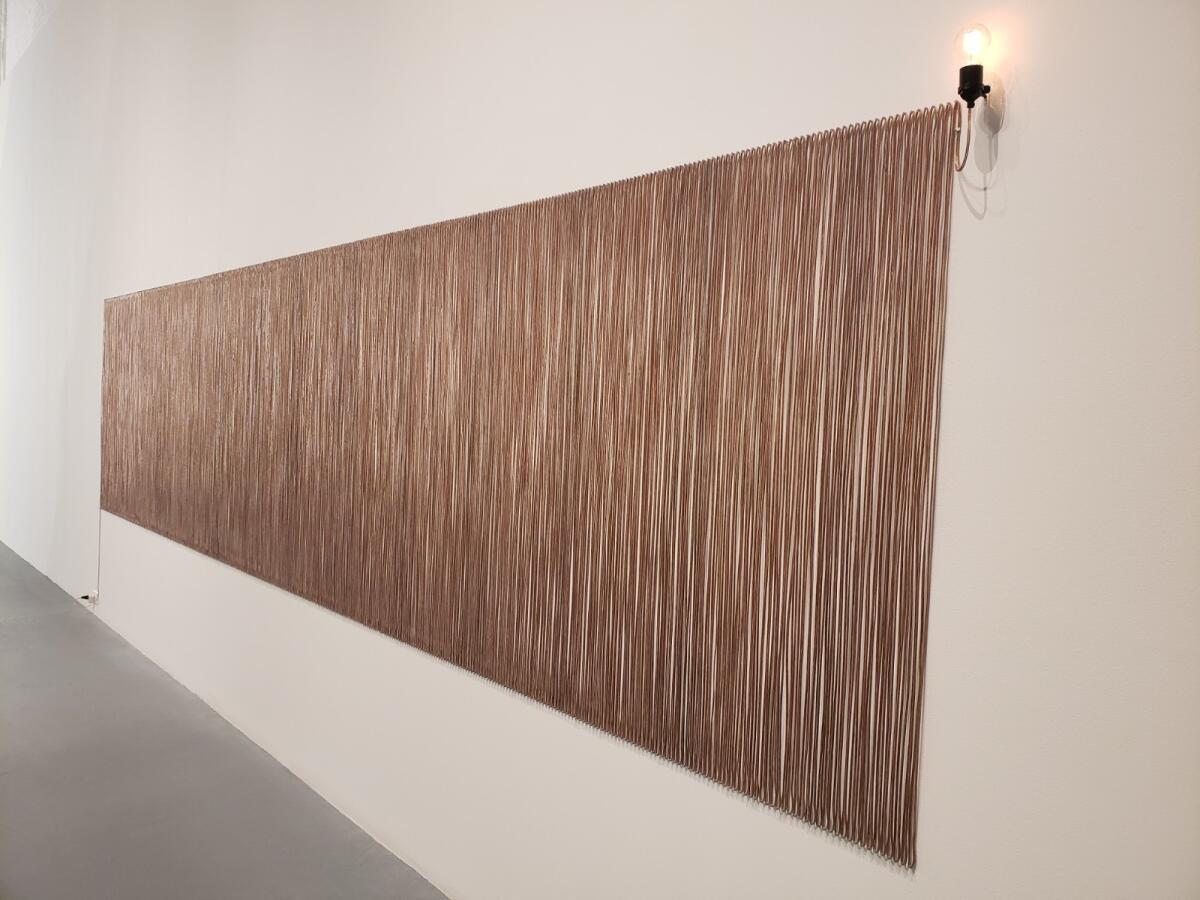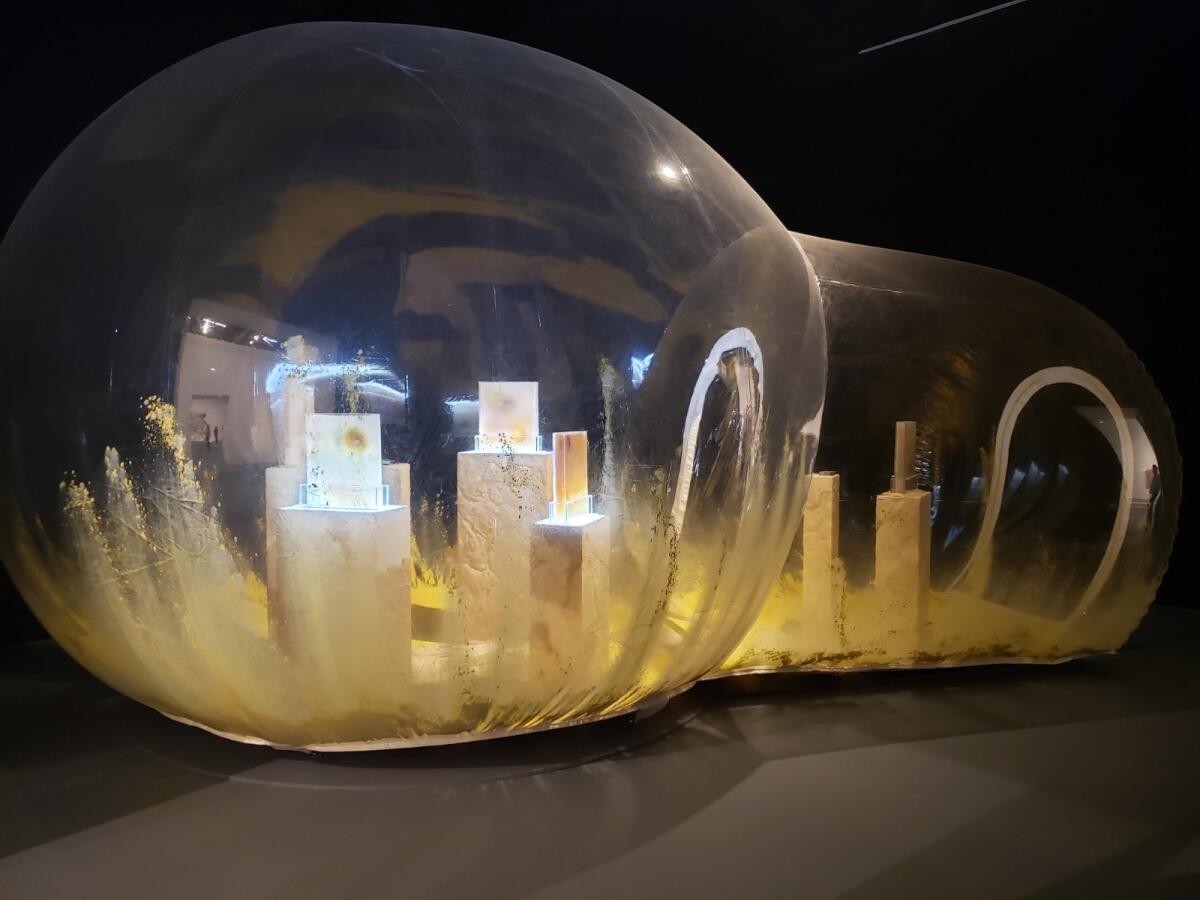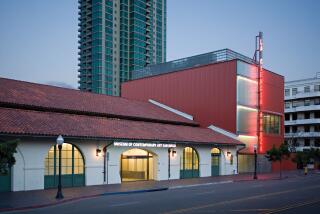Critic’s Notebook: MOCA on the rebound? Three strong shows and free entry are welcome signs of change
In a resurrection myth from ancient Greece, the powerful god Apollo accidentally kills Hyacinth, a beautiful Spartan prince, when a playful game of throwing a metal discus goes tragically awry. The mortal youth, struck in the forehead, dies in his divine lover’s arms
Later reborn as a notably phallic spring flower to assuage Apollo’s grief, Hyacinth, a representation of cycles of decay and renewal, makes an excellent motif for an anniversary celebration at the Museum of Contemporary Art. The renowned institution has had its troubles for the last decade, both financially and in terms of leadership. But as its 40th birthday rolls around, MOCA wants its public to know that the calamities are past. A new flowering is underway.
Time will tell, of course. But one artist is musing on Hyacinth and renewal.
“Open House: Elliott Hundley” is the first in a planned series of exhibitions that has become a general museum staple. Artists represented in the collection will be invited to select a show from among the museum’s holdings. Art does come from art, after all.
Hundley slyly built his show around “Hyacinth,” his elaborate 2006 collage composed from photographs, bits of cloth, painted papers, fringes and other fragile materials all pinned to a large wooden armature. Eight feet tall, just slightly larger than life, the construction leans against a wall.
Classical depictions of Hyacinth’s death typically show his exquisite, lifeless corpse held gently in despairing Apollo’s arms. Hundley’s subtly arranged composition recalls a body draped across a painting’s stretcher bars. In this exceptional mixed-media work, painting is likewise embraced and mourned.
Collage and assemblage are mediums born of the modern Industrial Age of mass production. The role that paintings historically played in Western cultural life changed. Hundley chose a diverse range of about 40 related works from MOCA’s collection — including everything from paintings to films.
At one end of the spectrum is “Small Rebus,” a 1956 hybrid masterpiece by Robert Rauschenberg, who also regularly riffed on classical myths. At the other is Betye Saar’s 2010 “The Destiny of Latitude & Longitude,” sailing ships and bundles of mottled gray hair housed inside an extravagant birdcage, silently singing a mordant refrain of freedom and captivity.
To elucidate his own collage, Hundley installed smartly chosen works on either side.
To the right, Alexis Smith’s “Blue Denim” features old posters for “Young, Willing and Eager” and “The Young Go Wild,” ‘60s B-movies about thrill-seeking youth. The clamps to a coil of actual jumper cables grip pictures of sexy young women, who jump-start the action.
To the left, Brenna Youngblood’s mixed-media painting “3 dollar bill (dirty money)” slips a trio of enlarged portraits of George Washington into the brushy soup of a large abstract painting’s badly scarred and bandaged surface. It’s as queer a take on the market domination of art as can be imagined.
Apollo’s eventual resurrection of the beautiful Hyacinth, who attained immortality, has wry resonance for an art museum. Hundley’s savvy show is a superlative launch for the series.
Two more exhibitions celebrate the museum’s role in the city’s emergence as an international powerhouse for new art. In all three, MOCA’s marvelous collection, more than 7,000 works, is the centerpiece.
“40 for L.A.,” organized by staffers Bryan Barcena, Amanda Hunt and Karlyn Olvido, is a multimedia display about MOCA’s institutional history. Together with timelines, historical ephemera and documentation from among 500 past exhibitions, it features a big wall with a silvery list of hundreds of artists’ names.
The names start with the late Magdalena Abakanowicz (Warsaw) and Eduardo Abaroa (Mexico City) and ends with Joe Zorrilla (Los Angeles) and Joe Zucker (New York). Akin to a museum’s donor wall naming financial benefactors, it gives pride of place to an international roster of artists whose work the museum conserves.
Artists are framed as civic leaders, a reality not often enough recognized. They after all launched the place, way back when.
The big event is “The Foundation of the Museum: MOCA’s Collection” at the Geffen Contemporary — the museum’s critically important, wildly influential warehouse space in Little Tokyo — organized by curators Bennett Simpson and Rebecca Lowery. The quality level is high. The curators have emphasized works related to the museum’s remarkable exhibition history.
MOCA distinguished itself by organizing the kinds of incisive, sometimes sweeping shows that its peers couldn’t — or at least didn’t — muster. They include histories of Minimalism, Conceptualism, feminist art, the initial phase of Land art, Case Study House architecture, Italian Arte Povera and more.
“Helter Skelter: L.A. Art in the 1990s” is credited as a pivotal moment in the region’s cultural history. Mounted in 1992 and offering an audacious look forward, rather than back, the subtitle slyly harnessed the cliché of Los Angeles as a city of the future. In the wake of the Reagan era’s reactionary outlook, plus a gnawing economic recession that saw the powerful, New York-based art market collapse, the show cemented the reputations of a slew of L.A. artists.
Chris Burden, Mike Kelley, Liz Larner, Paul McCarthy, Raymond Pettibon, Lari Pittman, Charles Ray — many are represented in the anniversary shows. The Geffen show’s titular work is Burden’s “Exposing the Foundations of the Museum,” first shown in the same location more than 30 years ago. This is its third MOCA outing.
Simplicity in conception meets difficulty in execution. The warehouse building’s concrete floor has been jackhammered. Three deep pits along a retaining wall were dug into the ground with a backhoe, stairs built to allow a visitor to descend and railings constructed to lessen liability. The museum’s physical foundation of steel beams planted in concrete footings stands exposed.
Only a museum like this one could accommodate such a work.
Climb down and your perception shifts a bit.
Turn around and the floor is now at eye level. People come, and people go. Life passes by aboveground while you remain metaphorically buried in the earth. The art museum’s physical foundation is concrete and steel, but mortality is its philosophical footing.
The museum is a place, in the words of Ananda K. Coomaraswamy, the great early 20th century Indian American curator at the Museum of Fine Arts in Boston, Burden’s birthplace, “where we display the damning evidence of a way of life that we have made impossible.”
Why three “tombs,” rather than just one or two? Once is chance, twice is coincidence, but a third time is a pattern. It’s foundational. Burden’s work is unexpectedly moving.
Several thematic rooms are featured. One has artists’ gifts of work by other artists, another focuses on complex ruminations on identity. A third considers light as material and metaphor.
Jac Leirner’s “Little Light” is a 50-foot wide rectangle made from a single, neatly nailed electrical cord looping up and down across the wall. One end is plugged into a live socket, the other wired into a small, glowing lamp — a literal echo of traditional painting’s power merged with a witty bright idea.


It hangs opposite a Jack Goldstein painting of jagged buildings silhouetted before bursts of bright light — a wartime bombing raid, perhaps, or a disorienting aurora borealis. Nearby, a 1969 push-pull installation of softly glowing colored neon tubes and blasting white theatrical scoop lights by Keith Sonnier hasn’t been seen since MOCA’s inaugural 1983 exhibition.
On the mezzanine, Jessica Stockholder’s brilliant monumental sculpture “White Light Laid Frozen” is like a painting pushed into three dimensions. Acquired two years ago, it is having its MOCA debut.
A horizontal white pedestal 23 feet wide and topped with white carpet supports 40 portable heating units, lined up like white sentinels beneath the icy white of a double row of fluorescent lights. Hovering above all that hot-and-cold purity, two ordinary metal office shelving units are suspended in space, held within a taut network of deep green bungee cords. Painted screaming yellow, the workaday world is elevated.
In the rear, scores of electrical cords sprawled across the floor keep the heaters and lights humming, a tangle that recalls the jumbled skeins of paint in a Jackson Pollock drip painting. Over at one end, a half-dozen bedroom lamps and a furry, rabbit-skin pelt slathered with yellow paint (think of the Post-Modern shamanistic work of influential German artist Joseph Beuys) are set out on six small tables.
Sawed up like puzzle pieces and fitted back together, the tables’ now-unified top is painted with intersecting geometric shapes, like a radical Suprematist painting by El Lissitzky. The Russian avant-garde, Abstract Expressionism, Post-Modern shamanism — Stockholder’s amalgamated installation is a marvel of pure artistic feeling, coaxed from ordinary objects of daily life.
Formally, its ancestry resides squarely in Rauschenberg’s combines — those revolutionary 1950s hybrids of painting and sculpture that partly inspired Hundley’s “Hyacinth.” MOCA, home to 11 masterpiece combines, is the world’s most important repository for Rauschenberg’s profoundly important genre.
So there’s a lot to see and consider in MOCA’s anniversary exhibitions. Inevitably, perhaps, they also bring to light shortcomings — one in particular, which has already generated some not unreasonable grumbling across social media.
Artistically, as a place for the production and consumption of new art, Los Angeles is a very different place today than it was in 1979. Socially, as a multiethnic, cosmopolitan center, the city itself has also been transformed.
L.A.’s first postwar generation of artists made art in an environment that ranged from sometimes hostile to mostly indifferent. Either way, there was nothing much to lose. Artists took advantage of that openness and independence. Their radical inventiveness was embraced by an institution to which the same mindset also gave birth.
During the last 40 years, however, the larger social milieu has also seen dramatic change. You’ve heard all the statistics, witnessed (or participated in) the city’s phenomenal growth. L.A. expanded by a third, from nearly 7.5 million county residents when MOCA got launched to more than 10 million now.
Who those people are is important. They constitute the art museum’s potential community.
Since the 1979 MOCA launch, the percentage of residents whose roots are traced to Mexico, Central and South America and the Asia-Pacific region has doubled. Growth in the Latinx community has been especially bountiful. Not only has California become the largest of the nation’s five majority-minority states, Los Angeles has emerged as one of the great capitals of Latin America.
BOB HOPE HOUSE: Lautner design in Palm Springs approaches masterpiece status »
Compelling works by Latinx and Asian artists are certainly on view in MOCA’s anniversary exhibitions. However, you don’t sense the monumental transformation of that civic context.
A severed head floating above a ruined landscape amid a shower of sometimes bloody, philosophically conflicting religious symbols in Filipino artist Manuel Ocampo’s untitled picture is as battered as the Spanish Colonial-style canvas on which it is brutally painted. Leirner, artist of the droll “Little Light,” is Brazilian.
Another lightbulb, this one a shape merged with a science lab beaker for a room-filling environment of inflated plastic by Anicka Yi, born in South Korea, is home to pedestals on which microbial yeast, mold and bacteria are relentlessly growing, eating up the once pristine setting. Persistence and transience are a contradiction with which art and museums both grapple.
Jaunty, lumpy monoliths built from an encrustation of sparkly glass beads by Mexican artist Raúl de Nieves are like humanoid stalagmites discovered deep within Plato’s cave. Clothing as costumes projecting the intricacies of social identity is a subject of photographs by the late Laura Aguilar.
There are others. No doubt there will be still more going forward — as there should be, given new MOCA Director Klaus Biesenbach’s stated commitments to embed the museum as deeply as possible into its community. That means artists, and it means the city too. Last month the museum happily unveiled a $10-million gift from Carolyn Powers, president of its board of trustees, to underwrite five years of free museum admission starting later this year.
Art museum membership is usually pitched as a way to get admission discounts, which debases the museum enterprise as a mere commercial transaction. Powers’ generosity pulls the plug on it — a gesture that, in our age of market dominance, couldn’t be more desirable. Following a tumultuous decade of fiscal and operational difficulties, MOCA may just be on a welcome — and timely — rebound.
=====
Museum of Contemporary Art
“Open House: Elliott Hundley” and “40 for L.A.”: MOCA, 250 S. Grand Ave., L.A., through Sept. 16.
“The Foundation of the Museum: MOCA’s Collection”: MOCA’s Geffen Contemporary, 152 N. Central Ave., L.A., through Jan. 27
Tickets: Until free admission starts later this year, entry is $8-$15 (free from 5-8 p.m. Thursdays). Closed Tuesdays.
Info: (213) 626-6222, moca.org
More to Read
The biggest entertainment stories
Get our big stories about Hollywood, film, television, music, arts, culture and more right in your inbox as soon as they publish.
You may occasionally receive promotional content from the Los Angeles Times.











